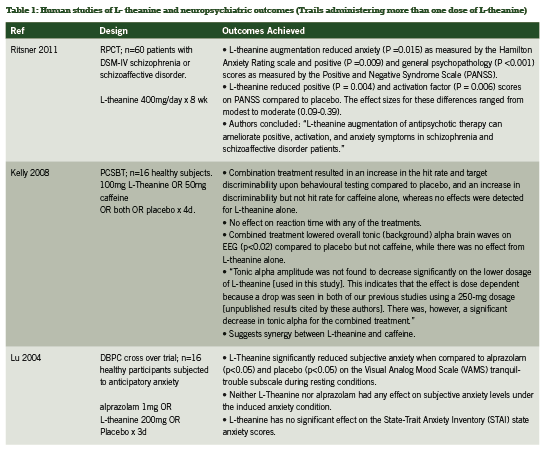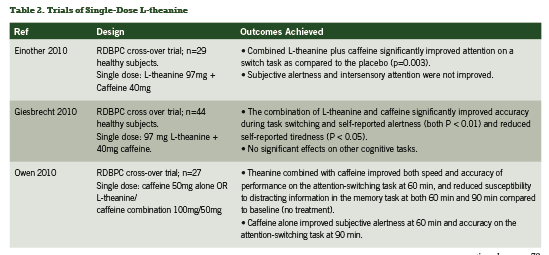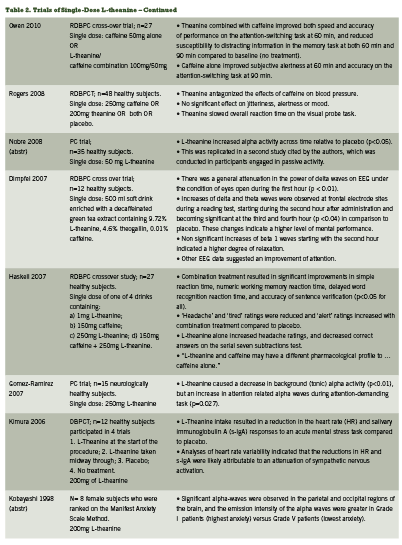L-theanine
Neuropsychiatric applications
The amino acid L-theanine is considered to be unique because it is found almost exclusively in Camellia sinensis, a popular tea plant (Monograph 2005). Theanine is the dominant amino acid found in teas leaves and is primarily responsible for the flavor of teas (Juneja 1999). Teas are one of the most common beverages globally consumed. The popularization of tea is said to be due to its ‘relaxation’ type effects (Juneja 1999). Interest in theanine was sparked due to its abundance in traditional diets (particularly in the Japanese diet) and its positive effects such as the ‘relaxed but alert’ state associated with consuming tea. Current literature, including human and non-human studies, suggests that L-theanine is a psychoactive compound that improves cognitive function and reduces anxiety (Gomez-Remirez 2007, Kimura 2007, Kobayashi 1998, Lu 2004, Nobre 2008, Yokogoshi 1998). Studies indicate L-theanine is also neuroprotective, possesses anti-cancer and immune supporting properties, and may help control hypertension (Bryan 2008, Juneja 1999, Monograph 2005, Nathan 2006). Each one of these areas warrants consideration. However, this article will focus on evidence that links L-theanine with cognitive and mood related effects.
Physiology
L-theanine (N-ethyl-L-glutamine) is a derivative of glutamic acid which is also a neurotransmitter in humans (Yokogoshi 1998). It is a water-soluble compound and is absorbed in the small intestine by a Na+ -coupled transporter found in the brush boarder membrane (Monograph 2005, Unno 1999). In the central nervous system (CNS), L-theanine crosses the blood-brain barrier through a leucinepreferring transport system in a concentration-dependant manner (Nathan 2006, Terashima 1999, Yokogoshi 1998). L-theanine is eliminated through hydrolysis to glutamic acid and thylamine in the kidneys (Unno 1999). Peak serum and hepatic concentrations of L-theanine occur 1 hr after administration, while brain levels peak after 5 hrs (Terashima 1999). Concentrations then decline gradually over 24 hrs following administration (Terashima 1999).
Toxicology
Borzelleca (2006) conducted a study to evaluate the safety of L-theanine. Rats were administered L-theanine via the diet at various concentrations (adjusted weekly) to sustain target doses of 1500, 3000, and 4000 mg/kg bw/day for 13 weeks. The monitored parameters of adverse effects included; behavior, morbidity, mortality, body weight, food consumption, clinical chemistry, hematology, and unrinalysis. The results were as follows:
• No treatment-related deaths
• Lower body weights in both female and male animals were observed at 3000 and 4000mg/kg bw/day doses (p< 0.05) but was determined to be due to significantly lower food consumption (unpalatability of diet) • No significant behavioural changes
• Reduced locomotor activity in males at weeks 3 and 14 but deemed unrelated to treatment (biological significance is unknown)
• No treatment related adverse effects related to clinical pathology were reported.
It was concluded that L-theanine is well tolerated and the LD50 is greater than 5000 mg/kg in rats, exponentially higher than the dose used for therapeutic administration in humans (Borzelleca 2006, Monograph 2005). Mutagenic or carcinogenic risks were not found in animals or bacteria (Borzelleca 2006, Monograph 2005).
Non-Human Studies
Although animal studies are not directly clinically applicable, the early in vivo evidence provides an understanding of the basic mechanism by which L-theanine exerts it neuropsychiatric effects, and the basis upon which further human investigations were conducted. A brief discussion of these findings is provided here.
Yokogoshi (1998) investigated (i) the transport system of theanine through the blood-brain barrier and (ii) the effects of theanine on brain monoamine (eg. dopamine) concentrations and the activity of dopaminergic neurons. It was determined that theanine competitively used the leucine- preferred transport system (LTS) to cross the blood brain barrier, since high concentrations of theanine appeared to affect levels of other amino acids that used the LTS. Non-LTS amino acid concentrations were unaffected. Catecholamines and 5-hydroxyindole levels were increased after theanine administration. This was especially noticed in the striatum where dopaminergic neurons are highly concentrated. Dopamine concentrations increased following theanine injection, but further investigation was suggested in order to more directly correlate theanine administration with dopaminergic effects. Collectively, these findings suggest that L-theanine may alter brain monoamine concentrations, thereby affecting cognitive function and mood. In this study serotonin concentration in the stratum and hippocampus were elevated, however, a subsequent study indicated a general decrease of serotonin release (Bryan 2008). It was suggested that theanine decreases serotonin levels only when caffeine is present (Bryan 2008, Nathan 2006, Yokogoshi 1998).
Lending support to such a caffeine-theanine interaction, another study demonstrated that theanine has antagonistic effects on caffeine’s stimulatory action. Kakuda (2000) monitored brain waves, using electroencephalography (EEG), after I.V. administration of caffeine and theanine in rats. The minimum dose of five micromol/kg body weight was determined to be the level at which caffeine was stimulating according to brain wave monitoring. Injection of theanine at a similar concentration inhibited caffeine’s stimulatory action; however, injection of theanine alone at levels of 1 -2 micromol/kg caused excitatory effects. These results suggest that theanine has inhibitory effects on caffeine’s stimulatory actions, but dose- dependant excitatory effects when administered alone. At the human level, this interaction has been confirmed by some studies while not in others, such as Rogers (2008) wherein theanine had no antagonistic effect on caffeine with respect to jitteriness, alertness or mood (please see Table 1 for summary).
Human Studies
Thirteen human studies were identified of L- theanine for impact on neuropsychiatric outcomes (see Table 1 and Table 2).
A novel trial administered 400mg/day of L- theanine as addon to antipsychotic treatment in randomized, double- blind, placebo controlled fashion to 60 patients with a DSM-IV diagnosis of schizophrenia or schizoaffective disorder (Ritsner 2011). Outcome measures included the Positive and Negative Syndrome Scale (PANSS), the Hamilton Anxiety Rating Scale (HARS), The Cambridge Neuropsychological Test Automated Battery (CANTAB), side effects and quality of life. Forty patients completed the eight week trial. Last observation carried forward (LOCF) was applied to the statistical analysis, and therefore 12 patients who dropped out of the trial between weeks four and six were included in the analysis.
L- theanine administration achieved significant benefit to the positive scores of the PANSS (p=0.009) compared to placebo, but failed to impact the PANSS negative subscales (p>0.05). On the five-Factor PANSS model the following was observed:
• Significant decrease of positive scores from week six onward
• Reduced activation (from week 2 onward)
• Reduced dysphoric mood (from week 2 onward)
•Reduced autistic preoccupations (from week 8 onward) On the HARS scores, improvement was seen on the second week compared to placebo. The results were as follows:
• Reduced anxious mood
• Reduced tension
No treatment- related adverse effects were observed. The authors conclude that co-treatment with antipsychotic therapy and Ltheanine improves anxiety and general psychopathology symptoms. Since the dopamine system has been implicated in schizophrenia, these findings would seem to support the preclinical indications that L-theanine acts upon this neurotransmitter pathway.
Lu and colleagues (2004) compared the anxiolytic effects of L-theanine to the benzodiazepine alprazolam. Sixteen patients were randomized to 200mg L- theanine, 1mg alprazolam, or placebo in double blind fashion. Participants were subjected to an experimentally induced anxiety related condition and also assessed under a relaxed condition. Acute effects of alprazolam and L-theanine were assessed by subjective self-reports of anxiety (Beck Anxiety Inventory (BAI), Visual Analogue Mood Scale (VAMS), and The State-Trait Anxiety Inventory (STAI)). The study determined that both L-theanine and alprazolam had no effect on subjective anxiety levels under the induced anxiety condition. On the VAMS tranquil-trouble subscale during resting conditions, L-theanine significantly reduced subjective anxiety when compared to alprazolam (p<0.05) and placebo (p<0.05). Therefore, L- theanine was able to produce a subjective anxiolytic outcome superior to alprazolam and placebo in a resting state.
Several human trials have investigated the impact of L- theanine on brain wave activity through application of EEG analysis. Reproducibly, L- theanine administration has been demonstrated to increase alpha wave activity (Gomez-Ramirez 2007, Kobayashi 1998, Nobre 2008) (see Table 1). Increased alpha wave activity is thought to indicate a state of wakeful relaxation. It has been associated with a general state of mental alertness or arousal; creativity; enhanced performance under stress; and improved cognitive function (learning and concentration), as well as decreased perceived anxiety (Bryan 2008, Gomez-Ramirez 2007, Mason 2001, Yokogoshi 1998).
Conclusion
L-theanine appears to be a safe, natural option for improving cognitive functioning such as attention, learning, and concentration. Evidence also suggests mood modulating effects (e.g. ‘relaxation’, sedation) which could be beneficial for improving anxiety related symptoms. Therapeutic dosage ranges from 50mg to 200mg and appears to complement conventional therapies well. Although the evidence to date is promising, the human level studies are minimal at present. Further human clinical trials are needed. In the mean time, dietary sources of L-theanine (green tea, black tea, white tea) appear to be beneficial to health and can be considered as a simple way to enhance or improve cognitive function and relaxation; administration of L-theanine can be considered as a complementary treatment for anxiety.
References
Bryan J. Psychological effects of dietary components of tea: caffeine and L-theanine. Nutr Rev. 2008; 66(2): 82-90.
Borzelleca JF, Peters D, Hall W. A 13-week dietary toxicity and toxicokinetic study with l-theanine in rats. Food Chem Toxicol. 2006 Jul;44(7):1158-66.
Dimpfel W, Kler A, Kriesl E, Lehnfeld R, Keplinger-Dimpfel IK. Source density of the human EEG after ingestion of a drink containing decaffeinated extract of green tea enriched with L-theanine and theogallin. Nutr Neurosci. 2007; 10(3-4): 169-180.
Einöther SJL, Martens VEG,Rycroft JA, De Bruin EA. L-Theanine and caffeine improve task switching but not intersensory attention or subjective alertness. Appetite. 2010; 54: 406-409.
Giesbrecht T, Rycroft JA, Rowson MJ, De Bruin EA. The combination of L-theanine and caffeine improves cognitive performance and increases subjective alertness. 2010: 13(6): 283-290.
Gomez-Ramirez M, Higgins BA, Rycroft JA, Owen GN, Mahoney J, Shpaner M, Foxe JJ. The deployment of intersensory selective attention: a high-density electrical mapping study of the effects of theanine. Clin Neuropharmacol. 2007; 30(1): 25-38.
Haskell CF, Kennedy DO, Milne AL, Wesnes KA, Scholey AB. The effects of L-theanine, caffeine and their combination on cognition and mood. Biol Psychol. 2008; 77: 113-122.
Juneja LR, Chu DC, Okubo T, Nagato Y, Yokogoshi H. L-theanine – a unique amino acid of green tea and its relaxation effect in humans. Trends Food Sci Tech. 1999; 10: 199-204.
Kakuda T, Nozawa A, Unno T, Okamura N, Okai O. Inhibiting effects of theanine on caffeine stimulation evaluated by EEG in the rat. Biosci Biotechnol Biochem. 2000; 64(2): 287-293.
Kelly SP, Gomez-Ramirez M, Montesi JL, Foxe JJ. L-theanine and caffeine in combination affect human cognition as evidenced by oscillatory alpha-band activity and attention task performance. J Nutr. 2008; 138: 1572S-1577S.
Kimura K, Ozeki M, Juneja LR, Ohira H. L-theanine reduces psychological and physiological stress responses. Biol Psychol. 2007; 74: 39-45.
Kobayashi K, Nagato Y, Aoi N, Juneja LR, Kim M, Yamamoto T, Sugimoto S. Effects of L-theanine on the release of α-brain waves in human volunteers. Nippon Nōgei Kagakukaishi. 1998; 72:153-157. (Abstract). Accessed on Google Scholar, March 2011.
Lu K, Gray MA, Oliver C, Liley DT, Harrison BJ, Bartholomeusz CF, Phan KL, Nathan PJ. The acute effects of L-theanine in comparison with alprazolam on anticipatory anxiety in humans. Hum Psychopharmacol Clin. 2004; 19: 457-465.
Mason R. 200 mg of zen: L-theanine boosts alpha waves, promotes alert relaxation. Alternative & Complimentary Therapies. 2001; 91-95.
Monograph. L-theanine. Altern Med Rev. 2005; 10(2): 136-138.
Nathan PJ, Lu K, Gray M, Oliver C. The neuropharmacology of L-theanine (N-Ethyl-L-Glutamine): a possible neuroprotective and cognitive enhancing agent. Journal of Herbal Pharmacology. 2006; 6(2): 21-30.
Nobre AC, Rao A, Owen GN. Ltheanine, a natural constituent in tea, and its effect on mental state. Asia Pac J Clin Nutr. 2008; 17(S1): 167-168.
Owen GN, Parnell H, De Bruin EA, Rycroft JA. The combined effects of L-theanine and caffeine on cognitive performance and mood. Nutr Neurosci. 2008; 11(4): 193- 198.
Ritsner MS, Miodownik C, Ratner Y, Shleifer T, Mar M, Pintov L, Lerner V. L-theanine relieves positive, activation, and anxiety symptoms in patients with schizophrenia and schizoaffective disorder: an 8-week, randomized, double-blind, placebo-controlled, 2-center study. J Clin Psychiat. 2011; 72(1): 34-42.
Rogers PJ, Smith JE, Heatherly SV, Pleydell-Pearce CW. Time for tea: mood, blood pressure and cognitive performance effects of caffeine and theanine administered alone and together. Psychopharmacology. 2008; 195: 569-577.
Terashima T, Takido J, Yokogoshi H. Time-dependent changes of amino acids in the serum, liver, brain, and urine of rats administered with theanine. Biosci. Biotechnol. Biochem: 1999: 63:615-618
Unno T, Suzuki Y, Kakuda T, Hayakawa T, Tsuge H. Metabolism of theanine, γ-glutamylethylamide, in rats. J Agric Food Chem; 1999: 1593-1596.
Yokogoshi H, Kobayashi M, Mochizuki M, Terashima T. Effect of theanine, γ-glutamylethylamide, on brain monoamines and striatal dopamine release in conscious rats. Neurochem Res. 1998; 23(5): 667-673.










